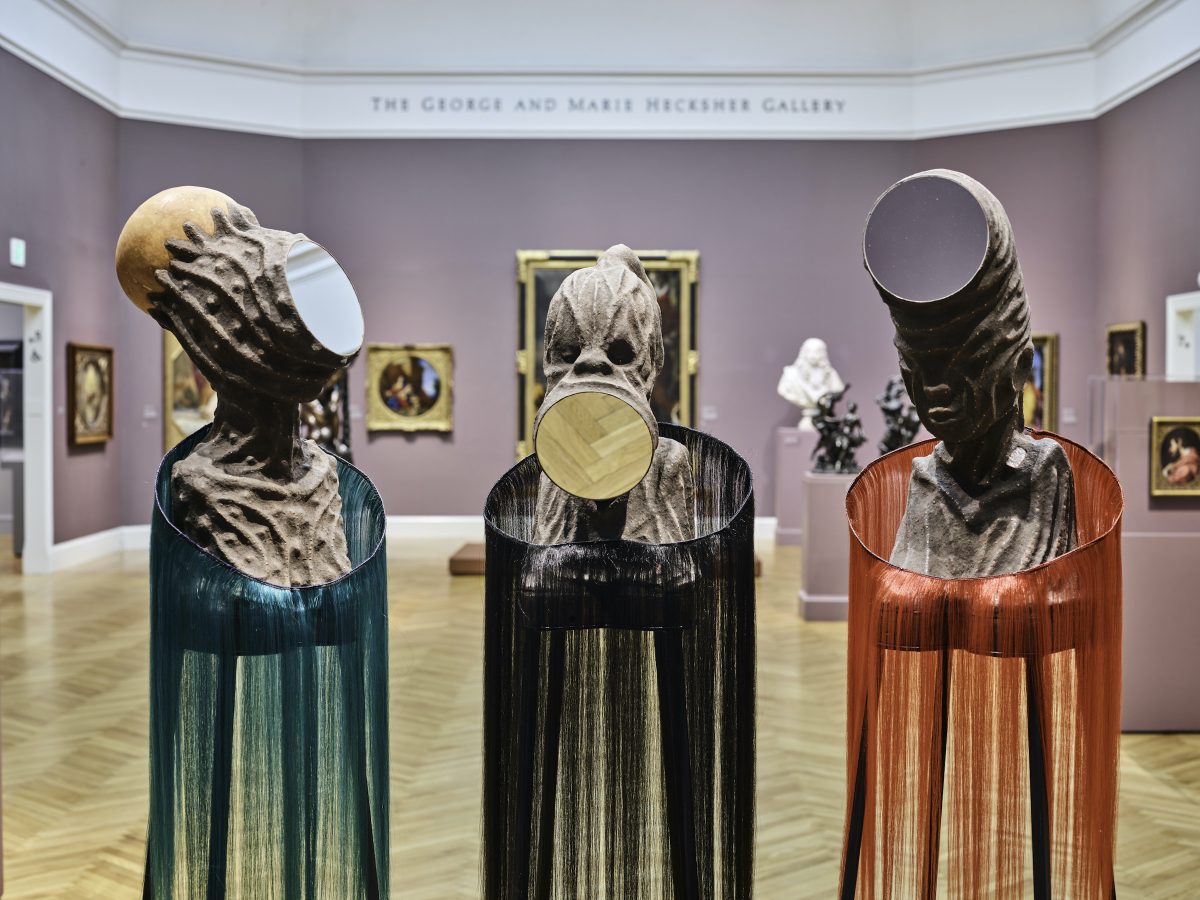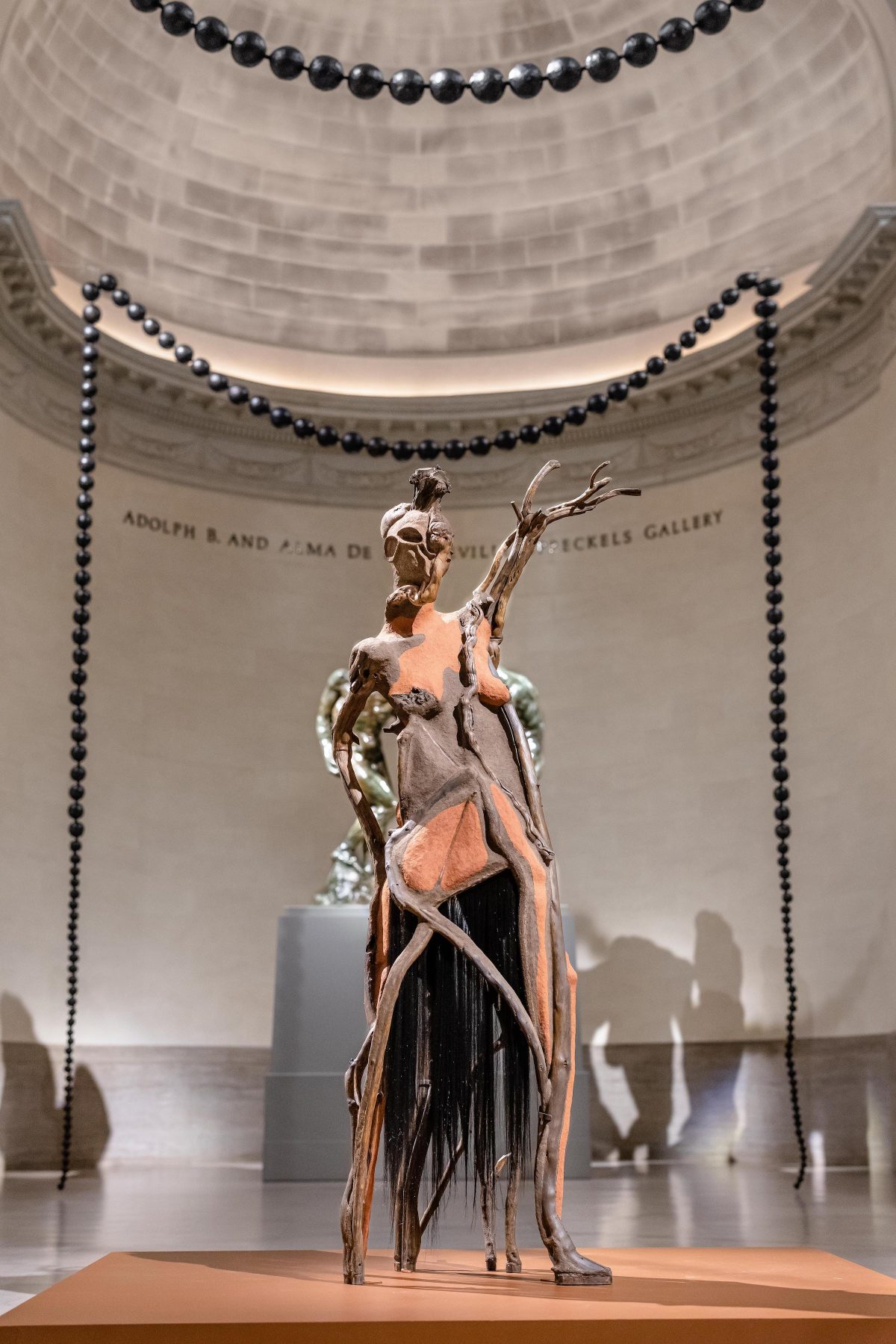
SAN FRANCISCO — I Am Speaking, Are You Listening? is a powerful new show by Wangechi Mutu at San Francisco’s Legion of Honor and exceeds her 2019 takeover of the Metropolitan Museum of Art’s façade, providing a model for how art institutions can begin the work of decolonizing and reckoning with systemic racism and sexism. The exhibition’s title can be read as both a sly reference to the role Black women play in society and a refusal of claims of white innocence. Mutu, who calls both Brooklyn and Nairobi home, is known for sampling global influences to create work that centers the Black female body and explores gender, race, colonialism, environmental degradation, and art history. Her large-scale sculptures, mixed-media paintings, and film use found materials like soil, tree branches, hair, charcoal, and cowrie shells common to the artist’s native Kenya to reimagine a human and ecological future.
The Legion of Honor, a replica of the French Pavilion at the 1915 San Francisco World’s Fair, itself a smaller version of the Palais de la Légion d’Honneur in Paris, is an unlikely site for the revolution. The neoclassical temple to European art perches atop a hill in San Francisco’s Land’s End, offering sweeping views of the bay and Golden Gate Bridge. It’s not easy to reach, and since the pandemic, the only bus providing direct access has been suspended. A cast of “Thinker” by 19th-century French sculptor Auguste Rodin looms large and isolated in a huge courtyard rimmed with columns. It’s intentionally imposing, and Mutu challenges this by positioning four large bronzes outside, signaling her (and our) arrival.

Two female figures, “Shavasana I” and “Shavasana II” (the corpse pose in yoga), lie prone on their backs at the “Thinker’s” feet and are covered with bronze mats, their arms and legs splayed at angles resembling the Crucifixion. Brightly manicured fingernails and dangling high heels further evoke the sacrifice of Black women, ignored by the white patriarchy. Up ahead, two hybrids glide towards the museum entrance. An alien atop a giant crocodile of East African mythology, her back ridged and fused to the beast’s, is called “Crocodylus.” “Mama Ray” is part sea creature, part war shield, part female alien. Textured and fluid, her imposing shape sweeps into a burnished face with large slit eyes and full dark lips.

Unlike Mutu’s Met commission, this collection continues the reclamation process into and throughout the museum. Once inside, visitors come face to face with “Water Woman,” a nguva or a siren from Swahili Coastal lore. Glossy black, with braided hair, webbed hands and a mermaid’s tail, the figure lounges in the center foyer. Mutu has used nguva mythology before, so it’s a familiar signifier anchoring an exhibition that radiates out into the museum’s five galleries. By placing pieces directly in conversation with the permanent European holdings, Mutu is simultaneously rejecting the notion of borders imposed at the Berlin Conference of 1884 (when Europe sliced up Africa); the so-called migrant crises in Europe and the USA, which she credits with influencing her alien figures; and traditional museum categorization and containment.
-

Wangechi Mutu, “Mirror Faced I” (2020), “Mirror Faced II” (2020), and “Mirror Faced III” (2020), installation view (© Wangechi Mutu, all rights reserved, courtesy the artist and Gladstone Gallery, New York and Brussels, photo by Randy Dodson, courtesy the Fine Arts Museums of San Francisco) -

Wangechi Mutu, “Outstretched” (2019), installation view (© Wangechi Mutu, all rights reserved, courtesy the artist and Gladstone Gallery, New York and Brussels, photo by Randy Dodson, courtesy the Fine Arts Museums of San Francisco)
The gallery of French and Italian Baroque and Rococo Art hosts two of the most arresting juxtapositions. “Outstretched,” a reclining figure with ash-colored, reptilian skin like a shield, face and hands hidden behind a fringe of red and black feathers, is a direct rebuke of the passive, pale nudes hanging behind her. At the front of the room, three aliens cluster, delicate fringed necklaces and tripod legs enhancing their otherworldliness. Like the caryatids Mutu created for the Met, their heads are angled mirrors, which Mutu values as ancient tools of inquiry and personal insight, reflecting the gallery and its visitors. The oblong heads invite comparison to the 17th-century Pope’s mitre behind them, while also evoking traditional lip plating and sci-fi film.

“Seeing Cowries,” a large, mound-shaped creature built around tree branches and studded with cowrie shells like an all-seeing oracle, guards the exhibition film, “My Cave Call.” Dedicated to Mutu’s mother, who witnessed Kenya’s bloody Mau Mau Rebellion against the British in the 1950s, it features Mutu lounging with a book on a blanket in a lush forest. A girl-child narrates a Giguyu origin myth, which soon turns to the story of colonization and war. Eventually, Mutu’s arms transform into tusks or roots that emit smoke as she smudges a cave. The ritual evokes the sentiments behind “Prayer,” a huge drape of beads framing the entire gallery that contains Rodin’s “Three Shades,” three hunched male figures designed to perch atop his unfinished “The Gates of Hell.” Mutu offers a different future: one of Black women in balance with land and sea, ready to enter a purified landscape.

Wangechi Mutu: I Am Speaking, Are You Listening? continues at the Legion of Honor (100 34th Avenue, San Francisco) through November 7.
0 Commentaires